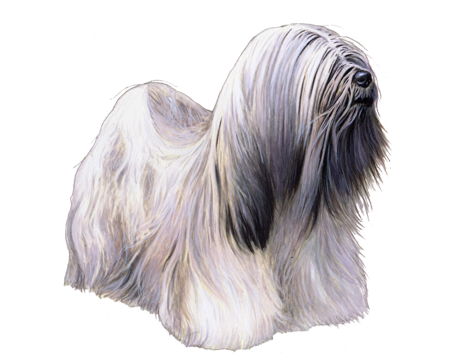
Maltese
Maltese are big bundles of energy in little bodies. This toy breed has been charming owners with their lively, playful personalities for centuries. Known for being affectionate and outgoing, Maltese make excellent family pets.
Interested in discovering if your dog is a Maltese?
Check out Wisdom Panel's DNA tests.

Maltese Traits
General Appearance
Maltese are head turners with their small statures and long, silky, white hair. They are light on their feet with jaunty gaits and lively movements.
Coat and Coloring
Maltese are known for the long, flat, silky hair that covers their bodies, reaching almost to the ground. There are no signs of curliness, kinkiness, or woolly texture in the hair. Some owners choose to tie the hair on the top of the head into a topknot. Pure white hair is the standard, though light tan or lemon on the ears is possible.
Distinctive Physical Traits
This toy breed has a compact body that is as long as it is tall. Maltese have sloping shoulders, deep chests, fine-boned, nicely feathered legs, and small, round feet. Their noses are black, and their eyes dark and round, giving them an alert but gentle expression.
Maltese Temperament
Maltese are small dogs with big personalities. Their fearlessness makes them great miniature alarm systems. Though they can be bold (and occasionally stubborn), Maltese are responsive, trusting, and affectionate with their families.
This breed is one of the more gentle-mannered toy dogs, but they have plenty of pep. Maltese are playful and vigorous and make wonderful family pets. They love to make friends with people and pets—and can quickly turn anyone unfamiliar with the breed into an enthusiastic fan.
Maltese can be energetic and love bounding around the yard or trotting around town but still appreciate a good cuddle. Thanks to their small size and quiet, adaptable natures, Maltese do well in apartments (and purses).


Maltese History
Hailing from Malta, Maltese have impressive histories that are said to go back twenty-eight centuries. The breed was most likely introduced to Malta by the Phoenicians, who ruled the Mediterranean. These little dogs achieved instant popularity. The Roman Emperor Claudius, and Publius, the Roman Governor of Malta, each owned a Maltese. Publius was said to be so devoted to his pet that he created art and poetry to immortalize the dog. Depictions of Maltese also appear on ceramics from the Golden Age.
Some believed Maltese were able to cure ailments. Owners often let the dogs sleep on the pillows next to them to take advantage of their healing properties. The breed later became a status symbol and fashion statement. Roman women were said not to be fully dressed without a Maltese peeking out from their garments.
Chinese breeders kept the Maltese from extinction after the fall of Rome. Their efforts to improve the dogs by crossing them with their native toy breeds led to a more refined breed. The "new" Maltese returned to Europe, where the dogs fast became the breed of choice for British aristocrats. The Maltese also became popular at dog shows. In 1877, the "Maltese Lion Dog" was shown at the first Westminster show in New York. They remain among the American Kennel Club's top 40 most popular dog breeds.
Maltese Care
Nutrition
Maltese require high-quality dog food that's appropriate for their breed size and life stage (e.g., puppy, adult, senior). Monitor their food intake to keep them from becoming overweight. Extra calories add up fast for such a tiny dog. Portion out their food with a measuring cup and limit treats to no more than 10% of their daily calories.
Grooming
Though Maltese are a low-shedding breed, maintaining their beautiful coats still requires regular grooming. Occasional baths (with conditioner) and daily brushing can keep their hair from becoming tangled or matted.
Maltese have fast-growing nails that require regular trimming to keep them from cracking, splitting, or causing pain when they walk or run.
Start a regular dental care routine when Maltese are young. Brushing their teeth and scheduling professional cleanings ensures good oral hygiene throughout their lives.
Exercise
Although Maltese are a moderately active breed, an occasional walk around the block or play session in a fenced yard is usually enough to tire them out. Provide opportunities for mental stimulation, such as games and puzzle toys, to keep these intelligent pups engaged and active. Despite their small size, Maltese are surprisingly athletic and enjoy activities such as competitive obedience or agility.
Training
Maltese are smart and stubborn, which means they can be easily trained but may not want to follow directions. A consistent training program that incorporates positive reinforcement and rewards can encourage them to participate in training sessions. To engage their outgoing personalities, try group sessions and games. Regular socialization is also important to help them feel comfortable with unfamiliar people, pets, and places.

Maltese Genetic Health Conditions
-
Chondrodystrophy (CDDY) and Intervertebral Disc Disease (IVDD) Risk
Chondrodystrophy (CDDY) is a skeletal disorder characterized by shortened limbs and abnormal early degeneration of the spinal discs, or intervertebral disc disease (IVDD), which predisposes to disc herniation.
-
Glycogen Storage Disease Type Ia (Discovered in the Maltese)
Glycogen Storage Disease (GSD) Type Ia is a severe metabolic disorder causing critically low blood sugar levels.
Knowing if your Maltese is a carrier or at-risk for these conditions can help you and your veterinarian plan for your pup’s lifelong care. With Wisdom Panel™ Premium, you can get results for over 200 genetic health tests.
Breed Group
Companion
This group consists of dogs typically bred for the specific purpose of human companionship, and many are popular pets because of their gentle nature. They became more common as the concept and luxury of dogs as pets prevailed.
Resources
https://www.akc.org/dog-breeds/maltese/
http://images.akc.org/pdf/breeds/standards/Maltese.pdf
Reviewed July 26, 2020 by Annette Louviere, DVM



























_Color.png)










